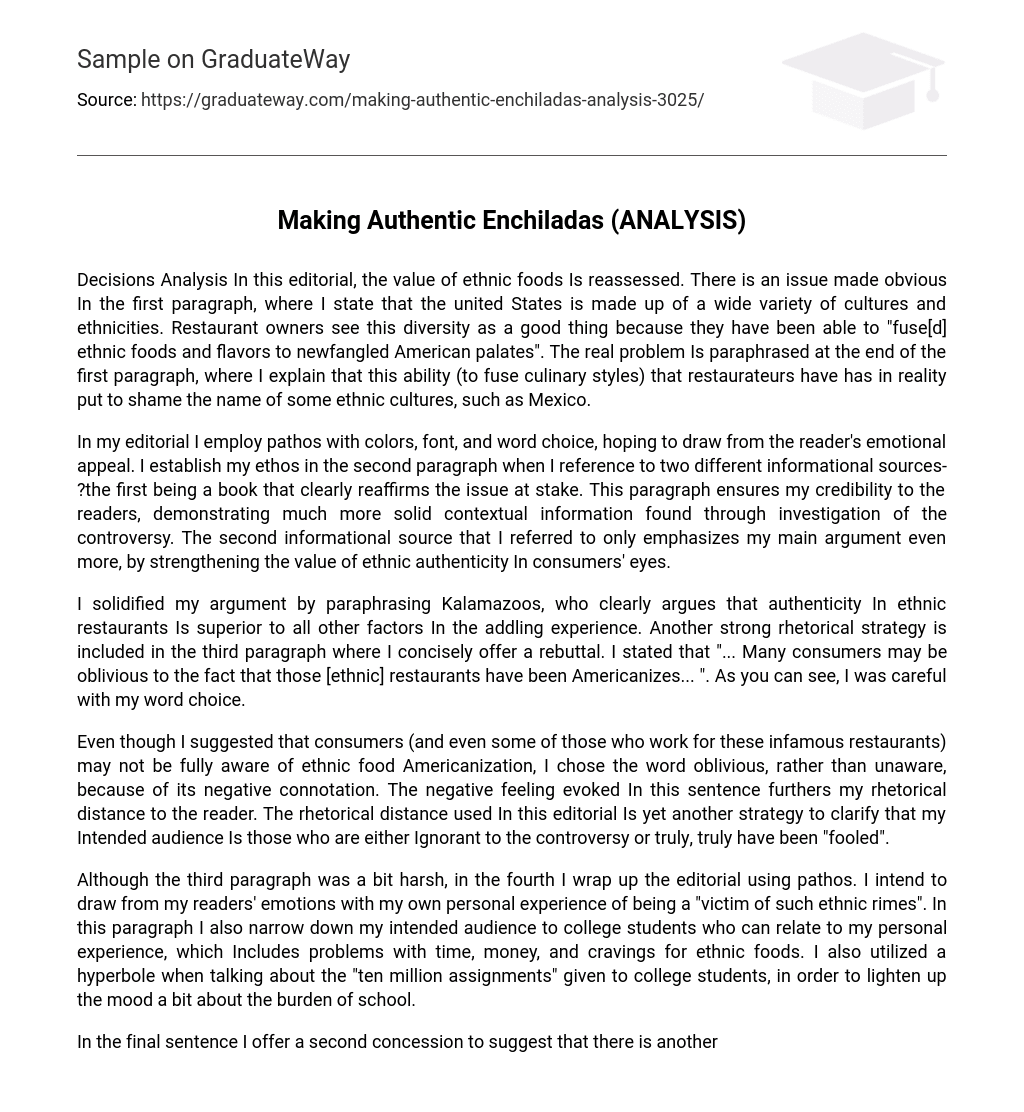Decisions Analysis In this editorial, the value of ethnic foods Is reassessed. There is an issue made obvious In the first paragraph, where I state that the united States is made up of a wide variety of cultures and ethnicities. Restaurant owners see this diversity as a good thing because they have been able to “fuse[d] ethnic foods and flavors to newfangled American palates”. The real problem Is paraphrased at the end of the first paragraph, where I explain that this ability (to fuse culinary styles) that restaurateurs have has in reality put to shame the name of some ethnic cultures, such as Mexico.
In my editorial I employ pathos with colors, font, and word choice, hoping to draw from the reader’s emotional appeal. I establish my ethos in the second paragraph when I reference to two different informational sources-?the first being a book that clearly reaffirms the issue at stake. This paragraph ensures my credibility to the readers, demonstrating much more solid contextual information found through investigation of the controversy. The second informational source that I referred to only emphasizes my main argument even more, by strengthening the value of ethnic authenticity In consumers’ eyes.
I solidified my argument by paraphrasing Kalamazoos, who clearly argues that authenticity In ethnic restaurants Is superior to all other factors In the addling experience. Another strong rhetorical strategy is included in the third paragraph where I concisely offer a rebuttal. I stated that “… Many consumers may be oblivious to the fact that those [ethnic] restaurants have been Americanizes… “. As you can see, I was careful with my word choice.
Even though I suggested that consumers (and even some of those who work for these infamous restaurants) may not be fully aware of ethnic food Americanization, I chose the word oblivious, rather than unaware, because of its negative connotation. The negative feeling evoked In this sentence furthers my rhetorical distance to the reader. The rhetorical distance used In this editorial Is yet another strategy to clarify that my Intended audience Is those who are either Ignorant to the controversy or truly, truly have been “fooled”.
Although the third paragraph was a bit harsh, in the fourth I wrap up the editorial using pathos. I intend to draw from my readers’ emotions with my own personal experience of being a “victim of such ethnic rimes”. In this paragraph I also narrow down my intended audience to college students who can relate to my personal experience, which Includes problems with time, money, and cravings for ethnic foods. I also utilized a hyperbole when talking about the “ten million assignments” given to college students, in order to lighten up the mood a bit about the burden of school.
In the final sentence I offer a second concession to suggest that there is another point of view In the controversy, which would say that there Is no time, nor money to be constantly trying to figure out what Is authentic and what Is not. However, I quickly made a suggestion that evokes emotional appeal and refutes that point of view with the following words ‘ . ‘ … But If you care in the least bit to appreciate authentic Mexican food… Here is the perfect The visuals provided in the editorial were in every bit intentional, as well, appealing to pathos.
As you can see in the images on the first page, the first photograph of enchiladas are intended to be the authentic version. The contrast and saturation of colors are intended to evoke emotions of desire in the viewer. The corners of the first hotplate are faded to convey a sense of dreaminess in the image- to make it seem heavenly. The way the first version of enchiladas were set up are also intended to seem more appealing, with the fork, knife, and drink making the viewer feel like they’re ready to indulge in something authentic, real, and wholesome.
In contrast to the colors of the first version of enchiladas, the colorless and lifelessness portrayed in the second photograph were intended to cause the viewer to feel eerie and slightly disgusted. It lacks energy and focuses more on what the entere lacks, rather than hat the meal entails-?as does the first photograph. The colors on the first photograph, as you may have noticed, mostly include green (avocado), white (cheese) and red (kitchenware), which were carefully chosen to represent the colors that all Mexicans pride on the most; the colors of their national flag.
Last, but not least, the recipe attached at the end of this editorial, supports any claims made by the images because they exemplify my credibility and knowledge on what authentic Mexican food is like. The recipe not only supports my ethos, but it also helps target my intended audience, which includes people who have some level f expertise when it comes to food, and a general interest to invest time in looking for good recipes.
However, the recipe also shows step-by-step instructions that break down the process for those who don’t usually use cook their own food. Through a recipe, I’m hoping to make authentic Mexican food appeal to the reader, and simple thing for one to do. This editorial logically implies that even though there is an issue with undignified ethnic foods, there is a solution. As one who is culturally undignified by Mexican food fusion, I can testify that it is indeed possible to reverse the lack of authenticity in ethnic foods.





